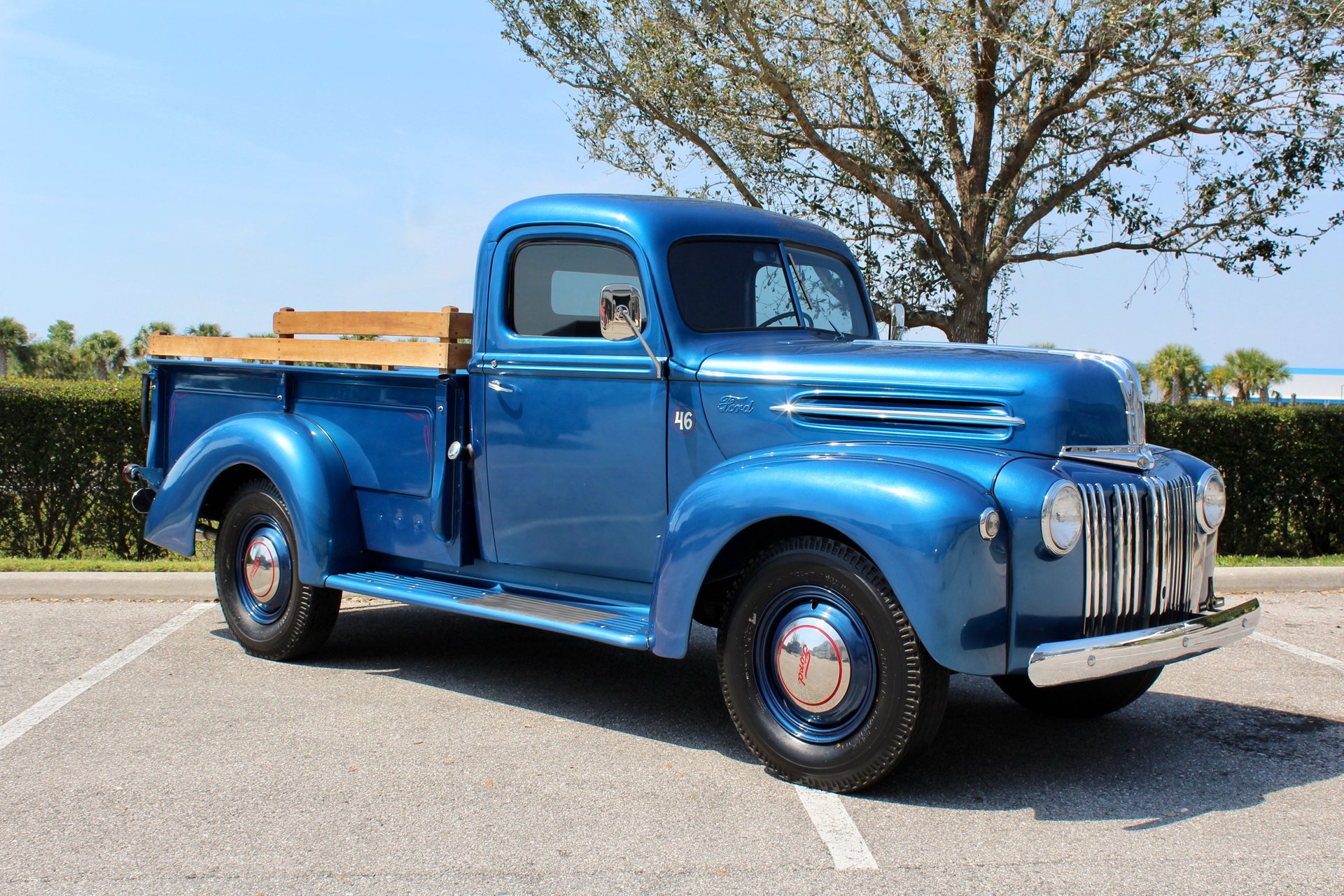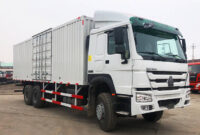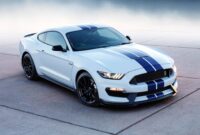1946 Ford Trucks For Sale: A Comprehensive Buyer’s Guide pickup.truckstrend.com
In the annals of automotive history, few vehicles evoke the spirit of resilience and rebirth quite like the 1946 Ford Truck. Emerging from the shadow of World War II, these robust machines were among the first full civilian production vehicles, signaling America’s return to peacetime prosperity and productivity. More than just utilitarian tools, the 1946 Ford Trucks quickly became symbols of a nation rebuilding, serving farms, businesses, and families across the country. Today, nearly eight decades later, these classic trucks continue to captivate enthusiasts, collectors, and those seeking a tangible piece of automotive heritage. Their timeless design, rugged reliability, and significant historical context make them highly sought-after vehicles in the classic car market. If you’re considering the exciting prospect of owning one of these post-war workhorses, this comprehensive guide will navigate you through everything you need to know about finding, evaluating, and acquiring a 1946 Ford Truck for sale.
The Post-War Workhorse: Why 1946 Ford Trucks Stand Out
1946 Ford Trucks For Sale: A Comprehensive Buyer’s Guide
The cessation of World War II in 1945 marked a pivotal moment for Ford and the entire American auto industry. Civilian vehicle production had largely halted during the war, with factories retooled for military output. As the war ended, Ford quickly pivoted back to civilian models, and the 1946 truck was among the first fruits of this transition. While largely resembling the pre-war 1942 models (due to limited time for new designs), the ’46 trucks represented a renewed commitment to everyday life.
What makes the 1946 Ford Truck so appealing today?
Firstly, its historical significance is undeniable. It’s a true post-war pioneer, embodying the optimism and drive of a nation getting back to business. Secondly, their classic design is timeless. Featuring rounded fenders, a distinctive grille, and a utilitarian yet appealing silhouette, these trucks exude vintage charm. Under the hood, many were powered by Ford’s legendary flathead V8 engine, known for its distinctive rumble, surprising torque, and relative simplicity. This engine, along with robust chassis and suspension components, contributed to their reputation for durability and reliability, making them true workhorses capable of handling tough tasks. For collectors and enthusiasts, the 1946 Ford Truck offers a unique blend of practicality, aesthetic appeal, and a deep connection to American history, making them not just vehicles, but rolling artifacts.
Understanding the Models: Types of 1946 Ford Trucks
When searching for a 1946 Ford Truck, it’s important to understand the different body styles and capacities that were available. While Ford’s modern F-Series nomenclature hadn’t yet been fully established, these trucks came in various configurations to meet diverse needs:
- Half-Ton Pickup (1/2-ton): This is arguably the most common and recognizable 1946 Ford Truck today. Featuring a single rear axle and a standard bed, these were popular for light hauling, farm work, and personal use. They typically came with a 114-inch wheelbase. Their compact size and classic pickup aesthetic make them highly desirable for restoration or customization into hot rods and restomods.
- Three-Quarter-Ton Pickup (3/4-ton): Offering increased payload capacity, the 3/4-ton models were built on a heavier chassis, often with a longer wheelbase (e.g., 122 inches). While visually similar to the half-ton, they were designed for more demanding tasks.
- One-Ton Truck (1-ton): These were the heavy-duty workhorses, built for substantial loads. They often featured a much longer wheelbase and could be configured as chassis-cabs for custom bodies, stake beds, or flatbeds.
- Panel Trucks: These enclosed utility vehicles were popular for businesses, offering secure and weather-protected cargo space. They featured side panels instead of windows and a rear door for loading. Panel trucks have a distinctive look and are often converted into unique custom vehicles or used for advertising.
- Chassis-Cab: Sold without a rear body, these were designed for commercial customers to add specialized bodies, such as stake beds, dump beds, or custom utility boxes. While less common to find in their original form, they can be excellent starting points for custom builds.
Knowing these distinctions will help you identify the specific model that best suits your vision, whether it’s a faithful restoration, a custom build, or a practical classic driver.

Where to Find 1946 Ford Trucks For Sale
The hunt for a 1946 Ford Truck can be an exciting journey. While they are not as ubiquitous as modern vehicles, several avenues exist for finding them:
- Online Marketplaces & Classifieds: Websites like eBay Motors, Hemmings Motor News, ClassicCars.com, and Bring a Trailer are prime resources. These platforms often feature detailed listings, multiple photos, and sometimes even videos. Be sure to use specific search terms like "1946 Ford Pickup" or "Ford Flathead Truck."
- Specialized Classic Car Dealers: Many dealerships specialize in vintage and classic vehicles. These dealers often have a curated inventory, and while prices might be higher, they typically offer vehicles that have been inspected or even partially restored.
- Auctions: Major classic car auctions such as Mecum Auctions and Barrett-Jackson frequently feature post-war trucks. Auctions can be a great way to find high-quality, fully restored examples, but be prepared for competitive bidding and buyer’s premiums.
- Local Classifieds & Word-of-Mouth: Don’t underestimate the power of local advertising (e.g., Facebook Marketplace, local classifieds websites) or simply networking within the classic car community. Many gems are found in barns or garages through personal connections. Attending local car shows and swap meets can also yield leads.
- Forums and Clubs: Joining vintage Ford truck forums or owner clubs (online and offline) can connect you with sellers. Enthusiasts often know where other vehicles are for sale, or might even be looking to sell their own project or finished truck.

When searching, be patient and cast a wide net. The right truck might be closer than you think, or it might require a bit of travel.
What to Look For: Key Considerations When Buying
Purchasing a vintage vehicle like a 1946 Ford Truck requires careful inspection and a clear understanding of its condition. Here are the key areas to scrutinize:
- Rust: This is the primary enemy of vintage vehicles. Thoroughly inspect the frame, cab corners, floorboards, bed, fenders, and door bottoms. Minor surface rust is manageable, but extensive structural rust (especially on the frame or critical body mounts) can be a deal-breaker or require significant, costly repairs. Bring a magnet to detect body filler over rust.
- Body Panels & Alignment: Check for accident damage, large dents, or poor previous repairs. Ensure doors, hood, and tailgate open and close smoothly, and that panel gaps are reasonably consistent.
- Paint: A fresh paint job can hide a multitude of sins. Look for signs of bubbling, cracking, or overspray, which might indicate rust underneath or a rushed job. Original patina is often preferred by many as it tells the truck’s story.
- Mechanical Condition:
- Engine: If it’s the original flathead V8, listen for knocks, excessive smoke, or unusual noises. Check for oil leaks. A professional compression test can reveal internal wear. If it’s a modern engine swap, ensure it’s professionally done and documented.
- Transmission: Check for smooth shifting, especially if it’s a manual. Listen for grinding noises.
- Brakes: Test the brakes thoroughly. Original drum brakes can be adequate but consider upgrades for modern driving.
- Suspension & Steering: Look for worn bushings, loose steering, or unusual noises over bumps.
- Electrical System: Test all lights, gauges, and accessories. Old wiring can be a fire hazard.
- Originality vs. Customization: Decide what you want. A fully original, numbers-matching truck will command a premium, as will a professionally built hot rod or restomod. A "driver quality" truck might have some modifications but is still functional. Be wary of poorly executed modifications.
- Documentation: Always ask for the title and verify its VIN. Any maintenance records, build sheets, or previous ownership history add significant value and peace of mind.
- Pre-Purchase Inspection (PPI): For any significant purchase, arrange for a qualified mechanic specializing in vintage vehicles to perform a comprehensive PPI. Their expert eye can spot issues you might miss.
Pricing Your Dream: Factors Influencing Value
The price of a 1946 Ford Truck can vary dramatically, ranging from a few thousand dollars for a project to well over $50,000 for a concours-quality restoration or a high-end restomod. Several factors contribute to its market value:
- Condition: This is the most significant factor.
- Project (Parts Truck): Often non-running, significant rust, missing parts. $2,000 – $8,000
- Driver Quality: Running and drivable, but with cosmetic flaws, some mechanical needs. $8,000 – $20,000
- Good Condition: Minor flaws, reliable driver, could be shown at local events. $20,000 – $35,000
- Fully Restored/Show Quality: Near-perfect condition, original or period-correct, minimal wear. $35,000 – $60,000+
- Restomod/Custom Build: Professionally built with modern running gear, suspension, interior. Price highly variable depending on components and quality, often $40,000 – $100,000+.
- Originality vs. Customization: A highly original, numbers-matching truck in pristine condition can fetch top dollar, as can a meticulously executed custom build. Poorly done modifications or non-original parts can decrease value unless they are high-quality upgrades.
- Rarity of Model/Options: While half-ton pickups are common, certain configurations or factory options might be rarer and command a higher price.
- Geographic Location: Prices can fluctuate based on regional demand and the availability of vehicles in certain areas.
- Market Demand: The overall health of the classic car market and current trends can influence prices.
It’s crucial to research recent sales of similar trucks to get a realistic idea of market value.
The Journey After Purchase: Ownership and Maintenance
Owning a 1946 Ford Truck is an incredibly rewarding experience, but it comes with unique considerations:
- Parts Availability: Surprisingly, many mechanical and body parts for 1946 Fords are still available through specialized classic Ford parts suppliers. Reproduction panels, trim pieces, and engine components are relatively common. However, some specific original components can be difficult to source.
- Common Issues: Be prepared for typical vintage vehicle quirks:
- Flathead V8: Prone to overheating if cooling systems aren’t maintained, and can develop oil leaks.
- Brakes: Original drum brakes require more stopping distance than modern discs. Upgrades are common.
- Electrical: Original 6-volt systems can be finicky; many owners convert to 12-volt for easier starting and modern accessories.
- Rust: Ongoing battle against corrosion, especially if driven in wet climates.
- Customization Potential: These trucks are a blank canvas for customization. From simple engine swaps to full frame-off restomods with modern powertrains, suspensions, and interiors, the possibilities are vast. This versatility contributes to their enduring popularity.
- Community and Resources: The vintage Ford truck community is vibrant and supportive. Owner clubs, online forums, and social media groups are invaluable resources for advice, parts sourcing, and sharing experiences.
Challenges and Solutions
While owning a 1946 Ford Truck is a joy, be aware of potential challenges and their solutions:
- Finding an Unmolested Example: Many 1946 trucks have been heavily modified over the decades. Finding a truly original, untouched example can be difficult. Solution: Broaden your search, prioritize solid foundations over perfect originality if you plan modifications.
- Rust Repair: Extensive rust can be costly and time-consuming to repair. Solution: Prioritize a truck with a solid frame and minimal structural rust, even if the body needs work. Seek out skilled fabricators.
- Upgrading for Modern Driving: Original components like drum brakes, manual steering, and basic lighting may not feel safe or comfortable in modern traffic. Solution: Plan for upgrades such as disc brakes, power steering, updated suspension, and brighter headlights. These significantly enhance drivability and safety.
- Insurance and Registration: Insuring a classic vehicle requires specialized policies. Solution: Contact classic car insurance providers (e.g., Hagerty, Grundy) who understand the unique needs of vintage vehicles. Be aware of your state’s classic vehicle registration requirements.
Conclusion
The 1946 Ford Truck stands as a magnificent testament to American ingenuity and perseverance. Owning one is more than just possessing a vehicle; it’s embracing a piece of history, joining a passionate community, and embarking on a journey of restoration, customization, or simply enjoying the open road in a timeless classic. Whether you envision a perfectly restored showpiece, a rugged daily driver, or a high-performance restomod, the 1946 Ford Truck offers an unparalleled foundation. With careful research, a thorough inspection, and a clear understanding of your goals, finding and acquiring your dream post-war Ford workhorse can be an incredibly rewarding experience, bringing years of enjoyment and a tangible connection to a pivotal era.
Price Table: 1946 Ford Trucks For Sale (Estimated Ranges)
| Condition Category | Description | Estimated Price Range (USD) | Key Considerations




